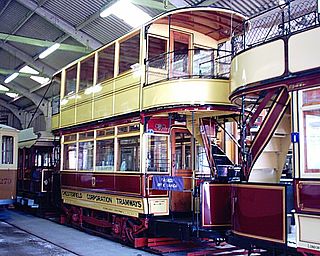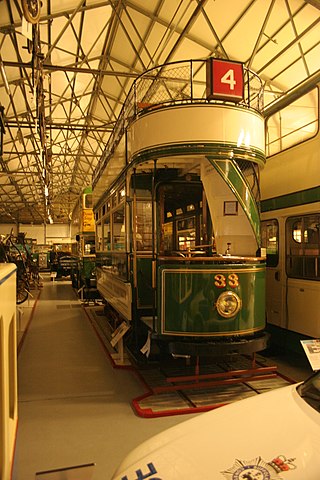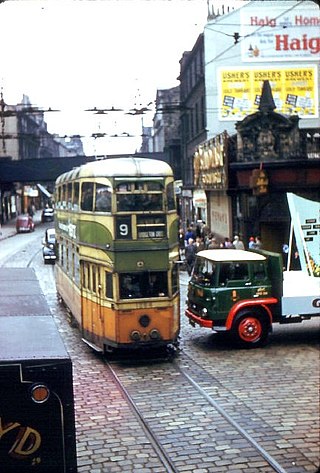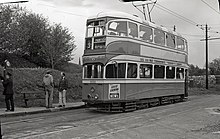
The National Tramway Museum is a tram museum located at Crich, Derbyshire, England. The museum contains over 60 trams built between 1873 and 1982 and is set within a recreated period village containing a working pub, cafe, old-style sweetshop and tram depots. The museum's collection of trams runs through the village-setting with visitors transported out into the local countryside and back. The museum is operated by the Tramway Museum Society, a registered charity.

A double-decker tram or double-deck tram is a tram that has two levels or decks. Some double-decker trams have open tops. Double-deck trams were once popular in some European cities, like Berlin and London, throughout the British Empire countries in the early half of the 20th century including Auckland, Christchurch and Wellington in New Zealand; Hobart, Tasmania in Australia and in parts of Asia. They are still in service or even newly introduced in Hong Kong, Alexandria, Dubai, Oranjestad, Blackpool, Birkenhead, Franschhoek, Auckland and Douglas, mostly as heritage or tourist trams.

The Chesterfield and District Tramways Company and its successors ran a tramway system in the Derbyshire town of Chesterfield, England. The first horse-drawn line opened in 1882, and in 1897, the system was taken over by Chesterfield Corporation, who extended and electrified it in 1904 and 1905. Additional tramcars were purchased, but two had to be scrapped after a disastrous fire at the depot in 1916. The system suffered from a lack of maintenance as a result of reduced staffing levels during the First World War, and the trams were replaced by trolleybuses in 1927.

The Ipswich Transport Museum is a museum in Ipswich, Suffolk, England, devoted principally to the history of transport and engineering objects made or used in its local area.

Glasgow Corporation Tramways were formerly one of the largest urban tramway systems in Europe. Over 1000 municipally-owned trams served the city of Glasgow, Scotland, with over 100 route miles by 1922. The system closed in 1962 and was the last city tramway in Great Britain.

The Riverside Museum is a museum in Glasgow, designed by Zaha Hadid Architects, housed in a building at Pointhouse Quay in the Glasgow Harbour regeneration district of Glasgow, Scotland. The building opened in June 2011, winning the 2013 European Museum of the Year Award. It houses many exhibits of national and international importance. The Govan-Partick Bridge will provide a pedestrian link from the museum across the Clyde to Govan. It is set to be completed in 2023.

Leeds Corporation Tramways formerly served the city of Leeds, England. The original trams were horse-drawn, but the city introduced Britain's first overhead-powered electric trams in 1891, and by 1901, electrification had been completed. The tramway opened on 29 October 1891.

Dundee Corporation Tramways formerly served the City of Dundee in Scotland. The corporation had financed the construction of a horse tramway in 1877, but had then leased it to the Dundee and District Tramways Company. They had replaced most of the horse trams with steam tram locomotives pulling trailer cars from 1884, but in 1897 the corporation decided that it would run the tramway system itself. After some negotiation and the payment of compensation, they took over the system in 1899, with a view to electrifying it. Electric trams started running in 1900, and the changeover was completed in 1902.

Aberdeen Corporation Tramways formerly served the City of Aberdeen, Scotland.
Edinburgh Corporation Tramways formerly served the City of Edinburgh, Scotland. The city used four-wheeled double-decked trams painted dark red (madder) and white – a livery still used by Lothian Buses and the post-2014 Edinburgh Trams.

The Glasgow trolleybus system operated in and immediately surrounding the city of Glasgow, Scotland, between 1949 and 1967, with the network reaching its largest extent in 1959. It was the only British system to open after World War II.

Between 1901 and 1949 Manchester Corporation Tramways was the municipal operator of electric tram services in Manchester, England. At its peak in 1928, the organisation carried 328 million passengers on 953 trams, via 46 routes, along 292 miles (470 km) of track.
Trams operated in Edinburgh from 1871 to 1956, and resumed in 2014. The first systems were horse-drawn, while cable-haulage appeared in the city in 1888. Electric trams first ran on systems in neighbouring Musselburgh (1904) and Leith (1905), meeting the Edinburgh cable-trams at Joppa and Pilrig respectively. Electrification meant cable trams last ran in 1923, with through running now possible to Leith and as far east as Port Seton. The various systems were operated by different private and municipal entities over the years; the Edinburgh and Leith systems had been merged under Edinburgh Corporation by 1920, but it wasn't until 1928, after the partial closure of Musselburgh line, that all trams operating in Edinburgh were in the sole control of the corporation. The last electric trams ran in 1956, but electric trams returned in 2014 with the opening of Edinburgh Trams. Many of the trams from the horse/cable/first electric era were built in Shrubhill Works. Two trams have been preserved, a horse tram and an electric tram, built by Shrubhill in 1885 and 1948 respectively. A 1903 Dick Kerr cable-tram has also been purchased for preservation. Remnants of the cable-tram system can be seen in Waterloo Place and Henderson Row, and of the Musselburgh line at Morrison's Haven.

The Adelaide trolleybus system formed part of the public transport network in Adelaide, South Australia from 1932 until 1963.

The Wolverhampton trolleybus system served the city of Wolverhampton, then in Staffordshire, England, for much of the twentieth century.
The South Lancashire trolleybus system once served towns in South Lancashire, England, including Atherton, Bolton, Swinton and Leigh and St Helens. Opened on 3 August 1930, it replaced the South Lancashire Tramways network.

Dundee and District Tramways operated a tramway service in Dundee between 1877 and 1899.
Halifax Corporation Tramways operated a tramway service in Halifax, West Yorkshire, England between 1898 and 1939. After considering lifts and inclined planes to assist trams in negotiating the steep hills to the south of the town, they obtained permission to build a conventional system in 1897, and the first three routes opened in 1898. By 1905 there were 37 miles (60 km) of track and 96 tramcars, supplied by two manufacturers. In 1921, an additional route was added to the system, and the Corporation embarked on a programme of building their own tramcars, some of which replaced existing vehicles, while some extended the fleet. During the 1930s, the trams were gradually replaced by motor buses, either run by the Corporation or by private companies, and the last tram ran on 14 February 1939.
Bradford Corporation Tramways were a tramway network in the city of Bradford, West Riding of Yorkshire, England which operated trams from 1882 until 1950 and trolleybuses from 1911 until 1972. The track gauge of the tramways was 4 ft.

Stockport Corporation Tramways operated a tramway service in Stockport, England, between 1901 and 1951. It was preceded by a horse tramway from Levenshulme to Stockport, which opened in 1880, and was ultimately run by the Manchester Carriage and Tramways Company. A second independent horse tramway opened in 1890, running to Hazel Grove. In 1899 the Corporation bought the first line, electrified it, and leased it back to the operating company. Their powers to buy the Stockport and Hazel Grove Tramway, authorised by the same Act of Parliament, were not exercised until 1905.


















